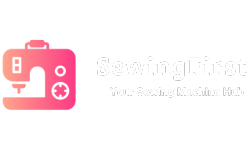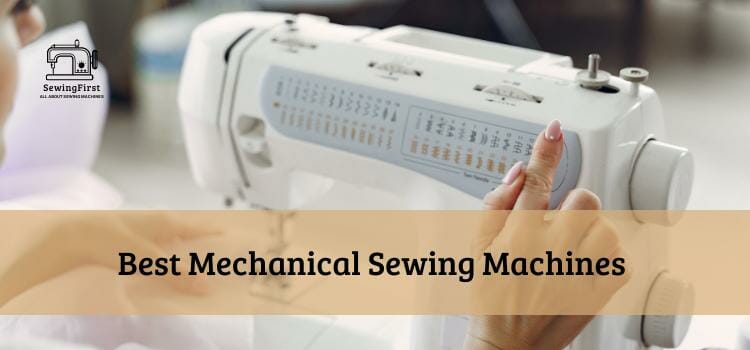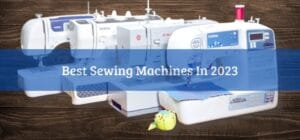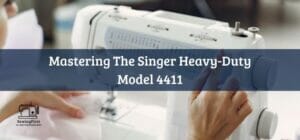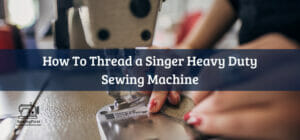Ah, there’s nothing quite like the hum of a mechanical sewing machine as it effortlessly stitches through the fabric.
You know what I’m talking about – that satisfying feeling of complete control over every stitch while you create something beautiful and functional with your own hands.
If you’re reading this, chances are you’ve experienced that undeniable connection to your craft and now understand why we’re so passionate about our beloved machines.
But let’s face it, not all mechanical sewing machines are created equal, and finding the perfect one for your needs can be a daunting task.
That’s where I come in! As an expert on these magnificent contraptions, I’ll guide you through some of the best mechanical sewing machines option available today.
Trust me when I say that once you find ‘the one,’ both you and your sewing projects will feel more connected than ever before.
So join me on this journey to discovering the top contenders in the world of mechanical sewing machines, and prepare yourself for a whole new level of stitching mastery!
Related Topic: Find Your Perfect Match: Top 9 Best Lightweight Sewing Machines Reviewed!
Table of Contents
ToggleList of Best Mechanical Sewing Machines
- Janome HD3000 Heavy-Duty
- Brother XM2701
- SINGER 4432 Heavy Duty
- Janome Arctic Crystal
- SINGER Tradition 2277
- Brother XR3774
- Bernette 35 sewing Design
- SINGER M1500
- SINGER MX60
Appeal Of Mechanical Sewing Machines
There’s something undeniably alluring about the best mechanical sewing machines on the market. Perhaps it’s the nostalgic charm, or maybe it’s because they offer a level of control and precision that many modern computerized models simply can’t match.
Regardless of the reason, there’s no denying that a top-notch mechanical sewing machine is worth its weight in gold for those who truly appreciate the art of stitching.
When looking at mechanical sewing machine prices, you’ll find an incredibly wide range – from affordable entry-level options to high-end professional models with more features than one could possibly need.!
Stay tuned as we unravel essential points to ponder when selecting among numerous remarkable candidates vying for the title of ‘your perfect mechanical sewing machine.’
Factors To Consider When Choosing A Machine
When selecting a mechanical sewing machine, price is always an important factor to consider.
Additionally, it’s important to know the motor power and the number of stitches the machine can do. You’ll also want to examine the bobbin system – is it top-loading or front loading?
Speed and weight are also important to assess, as are the light source and any included accessories.
Lastly, you’ll want to think about durability, the foot pedal, design, noise level, warranty, ease of use, and the brand.
Price
It’s no secret that price plays a significant role when searching for the best mechanical sewing machine. As an expert in this field, I can attest to the fact that you don’t always have to break the bank to find a reliable and efficient model.
Nevertheless, it’s essential to be aware of your budget constraints while also considering other factors like overall performance, durability, and ease of use.
When browsing through the best sewing machines consumer reports, take note of how different price points affect the features available on each model. While higher-priced models tend to offer more advanced capabilities and better build quality, there are plenty of affordable options that still deliver impressive results.
It’s all about striking a balance between what you’re willing to invest and what you expect from your new sewing companion.
Motor Power
Now that we’ve discussed the importance of finding a balance between price and features, let’s shift our focus to another crucial factor in your quest for the best mechanical sewing machine – motor power.
You see, my dear sewist friend, not all motors are created equal; some pack more punch than others, making them ideal for tackling thicker fabrics and more demanding projects without batting an eyelash.
Motor power is especially vital for those advanced sewers who have ambitious plans for their creative endeavors – after all, you wouldn’t want your sewing machine to be the bottleneck hindering your progress!
Stitches
Now, my dear sewist friend, let’s talk about something that truly stitches your sewing experience together – the variety of stitches a machine offers.
You might think you’ve found the best mechanical sewing machine on the market only to realize later it doesn’t cater to all those intricate designs swirling in your creative mind.
Don’t worry; I’m here to ensure that doesn’t happen!
The number and types of stitches available can make or break a sewing machine for many enthusiasts.
And remember: finding the best sewing machine isn’t always about getting one with countless features but rather choosing one that complements your individual style and creative aspirations.
1. Janome HD3000 Heavy-Duty
The Janome HD3000 Heavy-Duty Sewing Machine truly stands out as one of the best mechanical sewing machines on the market today.
Boasting an impressive lineup of features such as 18 built-in stitches, a top-loading jam-proof bobbin system, and a heavy-duty internal aluminum frame, this powerhouse is designed to cater to both beginners and advanced sewers alike.


Its sleek design and user-friendly interface make it not only pleasing to look at but also incredibly easy to navigate.
For those just starting their sewing journey, the Janome HD3000 is undoubtedly among the best mechanical sewing machine options for beginners. The instructional guide conveniently located in the top tray door offers valuable insights into stitch settings and presser feet suitable for various projects.
Additionally, with its simple push-pull bobbin winder, extra high presser foot lift, and removable free arm capabilities, even novice users can quickly become familiarized with essential sewing techniques.
Expanding your skills? Fear not; this remarkable Janome sewing machine has plenty to offer experienced sewists too! Advanced sewers will appreciate its versatile range of stitches – including buttonholes – along with customizable foot pressure adjustments that enable precise control over fabric handling during intricate tasks.
And let’s not forget about durability: the HD3000’s robust construction ensures longevity while maintaining optimal performance throughout countless creative endeavors.
Pros
- Built-in needle threader and top-loading bobbin
- Heavy-duty aluminum frame for durability
- 18 built-in stitches and one-step buttonhole
- Removable free arm for cylindrical items
- Includes hardcover for convenient storage
Cons
- Foot pressure adjustment instructions unclear
So go ahead – indulge yourself in exploring new possibilities brought forth by this exceptional piece of equipment!
2. Brother XM2701 (Mechanical Lightweight Sewing Machine)
Did you know that 51% of sewing enthusiasts find threading the needle to be one of their biggest challenges? Well, worry no more as Brother has come up with an amazing solution with its mechanical lightweight sewing machine – the XM2701.
This particular brother sewing machine is designed to make your sewing experience hassle-free and enjoyable, even if you’re just starting out or have been at it for years.


The Brother XM2701 offers a plethora of features including 27 unique built-in stitches such as a decorative, blind hem, zigzag, stretch stitches, and an auto-size buttonhole.
What sets this mechanical lightweight sewing machine apart is its automatic needle threader which effortlessly pushes the thread through the needle without causing strain on your eyes or hands.
The drop-in top bobbin system makes loading bobbins a breeze while also ensuring jam-resistant operation. With versatile free-arm functionality, this wonderful machine can cater to all sorts of everyday sewing projects regardless of whether you are a beginner or an advanced user.
There’s every reason why this remarkable piece should hold pride in place among your possessions. So go ahead and explore new horizons in stitching artistry with confidence & finesse using the Brother XM2701 Mechanical Lightweight Sewing Machine!
Pros
- Unique built-in stitches
- Automatic needle threader and drop-in top bobbin
- Versatile free arm
Cons
- Limited to US voltage
3. Singer 4432 Heavy Duty
Leaving the realm of lightweight machines, let’s delve into a workhorse that can stand up to heavy-duty projects.
The SINGER 4432 Heavy Duty Sewing Machine offers a robust and durable option for sewists who need something more powerful than your average mechanical sewing machine. With its sturdy metal frame and an impressive array of stitch applications, this model gives even some Bernina sewing machines a run for their money.


As one of the best professional sewing machines on the market, the SINGER 4432 is perfect for tackling large quilting projects or handling thick fabrics with ease. Boasting an impressive 110 stitch applications, it provides users with endless creative possibilities in fashion design, home décor, and beyond.
And if you’re specifically looking for the best mechanical sewing machine for quilting? Look no further! This powerhouse will impress both beginners and seasoned quilters alike.
Don’t be fooled by its strength – though it’s built to handle tough tasks, the SINGER 4432 still manages to maintain an intimate connection between user and fabric. Its intuitive design allows you to explore new techniques without feeling overwhelmed; all while delivering quick results thanks to its professional speed capabilities.
Pros
- Heavy duty metal frame ensures stability and durability
- Wide range of included accessories
- Built-in reverse lever enables
- Professional speed for efficient sewing and faster results
Cons
- 110V machine may not be suitable for regions with different voltage requirements
4. Janome Arctic Crystal (Easy-To-Use Sewing Machine)
The Janome Arctic Crystal sewing machine is a fantastic choice for both beginners and experienced sewists alike. With its easy-to-use design, this mechanical marvel offers the perfect blend of simplicity and functionality, allowing users to explore their creativity without feeling overwhelmed by complex features.


The heavy-duty interior metal frame ensures durability while maintaining smooth operation, making it an excellent investment that will last you years.
- 15 Built-In Stitches: Customize your projects with various stitches including straight, zigzag, overcast, blind hem, and more.
- 4-Step Buttonhole: Create professional-looking buttonholes with ease using the convenient built-in feature.
- Front-Loading Bobbin System: Easily access your bobbin thread with minimal hassle thanks to this user-friendly system.
- Adjustable Stitch Length & ZigZag Width: Personalize your stitch settings to suit your preferences or project requirements.
- Tutorial Videos & Instructional Manual: Get started quickly and confidently with helpful resources designed specifically for new sewists.
One of the standout characteristics of the Janome Arctic Crystal sewing machine is its versatility. It caters to different skill levels by offering customizable features such as adjustable stitch length and zigzag width. This allows users to adapt the machine according to their specific needs and progress at their own pace.
Moreover, the removable free arm enables sewists to tackle hard-to-reach areas like cuffs and collars effortlessly. With dual retractable spool pins conveniently placed on top of the machine, switching between threads has never been easier.
Pros
- 15 stitches, 4-step buttonhole for versatility
- Adjustable stitch length and zigzag width
- 3-piece feed dog system, removable free arm
- Beginner-friendly with tutorial videos, and quick start guide
Cons
- Heavy-duty metal frame may affect portability
5. Singer Tradition 2277 (Perfect For Beginners)
You might be thinking that the SINGER Tradition 2277 sewing machine is too basic for your needs, but let me assure you, it’s perfect for beginners.


The automatic embroidery needle threader on the SINGER Tradition 2277 is truly a lifesaver, saving precious time and eliminating frustration when threading needles. The adjustable stitch length and width allow for strong seams on any fabric type without bunching – talk about convenience!
Moreover, the fully automatic 1-step buttonhole feature delivers professional results at just the touch of a button. As if these amazing features weren’t enough, this powerhouse also boasts 97 stitch applications to suit all your creative endeavors.
Not only does this model perform beautifully, but it’s also built to last with its heavy-duty metal frame ensuring overall durability and skip-free sewing. Plus, the limited warranty provided covers various parts and components for up to 25 years on the sewing machine head – now that’s peace of mind!
Pros
- Time-saving automatic embroidery needle threader
- Adjustable stitch length and width for strong seams
- Fully automatic 1-step buttonhole for professional results
- 97 stitch applications for versatile sewing options
Cons
- 110-volt machine limited to United States and Canadian use only
6. Brother XR3774 Sewing And Quilting Machine
Moving on from the SINGER Tradition 2277, we now delve into another excellent option for sewing enthusiasts: the Brother XR3774 Sewing and Quilting Machine.


One of the standout features of the Brother XR3774 is its 37 unique built-in stitches, which include blind hem, decorative, quilting stitches, and even a one-step buttonhole function.
The automatic needle threader ensures you won’t struggle with threading anymore; just let the machine do all the work! Additionally, its jam-resistant drop-in top bobbin makes your sewing experience hassle-free as well.
Moreover, this fantastic model comes with an array of helpful accessories such as a machine cover, a wide table, eight sewing feet, an instructional DVD, and much more – everything you need to get started right away!
The Brother XR3774 doesn’t fall short in terms of versatility either. Its free arm design allows you to tackle various everyday sewing and quilting projects effortlessly – whether you’re just starting out or already have years of experience under your belt.
All things considered, this model proves itself to be an exceptional investment for anyone passionate about sewing or looking to improve their skills further. So go ahead and explore all that it has to offer!
Pros
- 37 built-in stitches for various projects
- Automatic needle threader and drop-in bobbin
- Includes machine cover, wide table, 8 feet, DVD
- Versatile free-arm design for sewing and quilting
Cons
- Intended for sale and use in the US only
- Warranty may be voided outside designated region
7. Bernette 35 Swiss Design
When it comes to Swiss design and engineering, the Bernette 35 sewing machine truly stands out among its competitors. This mechanical marvel offers a seamless blend of precision and efficiency, making it an ideal choice for beginners and seasoned sewers alike.
It’s straightforward controls and versatile stitch options make it incredibly user-friendly, while the durable construction ensures that this sewing machine will be a reliable companion for years to come.
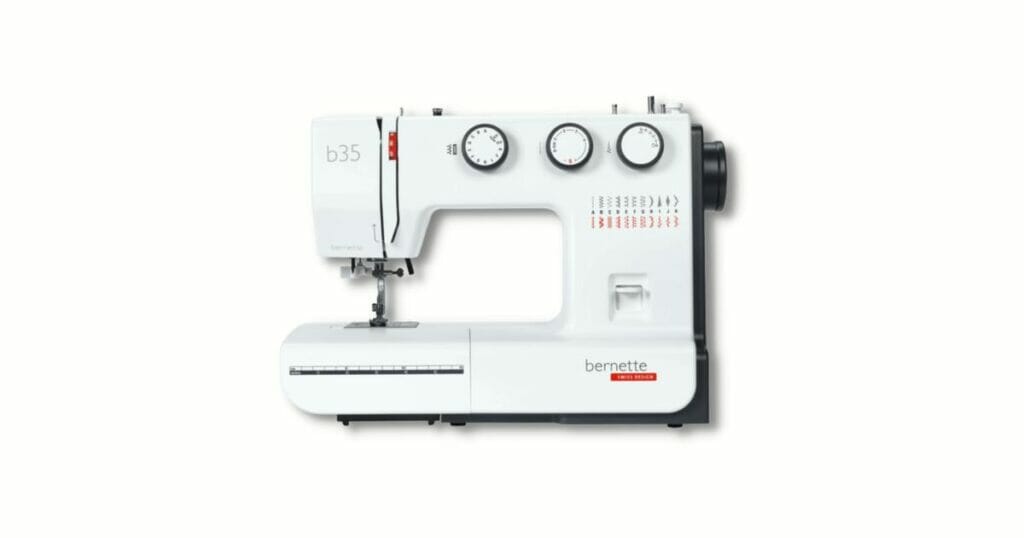

One of the key features that set the Bernette 35 apart from other models is its ability to handle various types of fabrics with ease. The impressive piercing power delivered by this machine ensures consistent stitching quality across all fabric types, allowing your creative projects to truly shine.
Not only does the Bernette 35 offer a wide range of stitches and presser feet, but it also boasts convenient extras like a manual needle threader and thread cutter – little touches that make your sewing experience even more enjoyable.
The thoughtful design elements incorporated into the Bernette 35 don’t end there; the two-step presser foot lift makes handling thicker layers of fabric virtually effortless. No longer will quilters or those working with multiple layers feel daunted by their projects!
Pros
- Budget-friendly mechanical sewing machine
- 23 stitches and 7 presser feet
- Easy stitch adjustment with 3 knobs
- Automatic 4-step buttonhole feature
Cons
- Manual needle threader and cutter`
- Storage space for sewing tools
8. Singer M1500
Did you know that nearly 60% of beginner sewists struggle with choosing the right sewing machine for their needs? It’s a daunting task, but fear not because the SINGER M1500 Mechanical Sewing Machine is here to save the day.
Designed with beginners in mind, this machine offers an easy-to-use experience without compromising on quality and performance. Its diverse range of stitch applications allows users to dabble in various projects – from fashion creation to simple mending tasks.


What sets the SINGER M1500 apart from other machines is its simplicity and efficiency. With its clearly labeled Stitch Selector Dial, selecting stitches has never been easier.
Furthermore, it takes out any guesswork by having preset stitch length and width options tailored specifically for each stitch type. This user-friendly approach ensures consistent results every time, making it perfect for those who are just starting their sewing journey.
The full metal frame construction provides stability while also ensuring long-lasting durability – a feature often overlooked in entry-level machines. Additionally, its front-loading bobbin system enables a seamless transition between threading processes and simplifies overall operation.
Pros
- 57 stitch options for various sewing techniques
- Easy stitch selection with Stitch Selector Dial
- Preset stitch length and width
- Four-step buttonhole for simple sewing
Cons
- Threading and bobbin winding challenges reported
9. Singer MX60 (Best Sewing Machine For Small Projects)
The SINGER MX60 is a true gem for those who love working on small projects. This compact and lightweight sewing machine is perfect for beginners, as well as experienced sewers looking to tackle smaller tasks with ease.
With its 57 stitch applications and easy-to-use features, the MX60 allows you to effortlessly create beautiful patterns and designs in no time at all. Plus, thanks to its portable nature, this versatile machine can be taken to classes or used in tight spaces without any hassle.


As a mechanical sewing machine expert, I must say that the performance of the SINGER MX60 truly impresses me. Its LED lighting ensures that your workspace remains well-lit, allowing you to focus on even the most intricate details of your project.
The pre-set stitch length and width make it incredibly simple for users to select their desired settings, while its 5.6-inch sewing space (needle to tower) provides ample room for maneuvering fabrics with precision.
With these points in mind, let’s move forward into our next section where we’ll delve into troubleshooting common issues faced by sewers using this lovely piece of machinery!
Pros
- A lightweight and portable design ideal for sewing classes or small spaces
- Pre-set stitch length and width simplify the sewing process for beginners
- 57 stitch applications cater to various sewing techniques and projects
- A full metal frame ensures durability and stability
Cons
- LED lighting may not provide sufficient illumination for some users
Troubleshooting Common Issues
Threading Problems can be a real pain, but they don’t have to be. I can walk you through the process so you can get back to sewing in no time.
Jamming Problems are usually caused by improper tension, so make sure you’re checking yours regularly.
Bobbin Problems can be tricky and often require taking apart the machine, but I’m here to help you figure it out.
With the right troubleshooting steps, you’ll have your best mechanical sewing machine up and running in no time!
Threading Problems
Threading problems can be so frustrating, right? You’re excited to start your project and suddenly, you find yourself dealing with a tangled mess of thread or skipped stitches.
As an experienced sewing machine expert, I’ve encountered these issues many times myself, and have learned the best ways to troubleshoot threading problems quickly.
- First, let’s talk about proper threading techniques. Trust me when I say that following the correct steps for threading is essential to avoid any headaches later on.
- To ensure a smooth sewing experience, always make sure the presser foot is up while threading; this opens the tension discs allowing the thread to properly pass through them. Additionally, take note of how the thread comes off the spool – it should flow smoothly without twisting or catching on anything.
- If you’re unsure which way your spool should spin in its holder, consult your manual because every brand has different recommendations.
- Lastly (and most importantly), maintain patience and focus throughout the process! We all know how easy it is to become frustrated or rush when things aren’t going as planned but trust me: taking those extra moments to stay calm and focused will save you time in the long run by preventing further complications.
A cool-headed approach combined with my expert advice will get you back on track before you know it—and no need for any ‘conclusions’ here—just happy sewing once more!
Jamming Problems
Now that we’ve tackled threading issues, let’s move on to another common frustration: jamming problems.
We’ve all been there—you’re in the zone, stitching away, and suddenly your machine grinds to a halt with thread bunched up beneath the fabric. Don’t fret; as an experienced sewing machine expert, I assure you it’s fixable!
- The key here is not panicking but instead taking a deep breath and methodically examining your machine for the cause of the jam. First things first—cut away any tangled threads gently using small scissors or snips.
- Next, remove the bobbin case to check if there are any visible issues like debris or lint buildup. If everything looks clear, rethread both top and bottom threads carefully following our previous tips on proper threading techniques. Lastly, don’t forget about tension settings! Incorrect tension can lead to bunching and jams too.
By combining this step-by-step approach with a calm demeanor (and perhaps some soothing music), you’ll have those pesky jams resolved in no time at all—and without leaving room for any ‘conclusions,’ just an enjoyable return to smooth sailing in your sewing adventures!
Bobbin Problems
Speaking of bobbin issues, they’re often the culprits behind many sewing mishaps. As a sewing machine connoisseur, I can’t emphasize enough how important it is to pay attention to your trusty little bobbin. It might be small, but it plays a huge role in ensuring smooth stitching experiences.
- The first thing you should do when you suspect your bobbin is causing trouble is to check if it’s wound correctly and evenly—uneven winding can lead to tension problems or the thread getting caught during sewing.
- Next, inspect the bobbin case for any signs of wear and tear; sometimes those tiny notches or grooves that appear over time can disrupt the proper flow of the thread.
- And don’t forget about compatibility! Ensure you’re using the right type of bobbin specifically designed for your machine model.
By giving your bobbins some much-needed love and care (and maybe even whispering sweet nothings), you’ll find yourself bonding with them on a deeper level—and more importantly, preventing further hiccups in your creative journey!
Maintenance And Care Tips
It’s important to keep your mechanical sewing machine clean and in good condition. Regular cleaning and maintenance will help keep it running smoothly.
Oiling and lubricating your machine is a must; use the right kind of oil for your machine and make sure all moving parts are lubricated.
To troubleshoot, first, make sure you’re using the right needle and thread, then check for any blockages in the bobbin area. If that doesn’t work, you might need to consult a repairman.
Following these steps will help ensure your mechanical sewing machine runs like a dream!
Cleaning The Machine
Listen up, sewing enthusiasts! I know we all love the feeling of creating beautiful projects with our trusty mechanical sewing machines. But let’s face it, none of us can work our magic without a well-maintained and clean machine.
So today, we’re going to dive into the world of cleaning your beloved machine like an expert that will make her purr like a kitten.
- First things first – you’ve got to be gentle with your baby. When cleaning your mechanical sewing machine, always remember that less is more. Begin by unplugging the machine and removing any dust or lint buildup from its various parts using a soft brush or cloth.
- For those hard-to-reach areas, try using compressed air (but not too close) to blow away debris; this technique works wonders for keeping everything running smoothly without causing damage. If needed, apply oil sparingly on moving parts according to your manufacturer’s instructions but avoid over-oiling which may lead to performance issues down the road.
- Last but not least, don’t forget about the bobbin case and tension assembly – these crucial components need some TLC too! To do so, remove them carefully and use a small brush or cotton swab dipped in rubbing alcohol to gently cleanse away any dirt or grime that has built up over time.
Trust me when I say that regular cleaning sessions are essential for maintaining optimal performance levels and ensuring the long-lasting durability of your cherished mechanical sewing machine. Keep up this routine maintenance practice and watch how effortlessly she runs stitch after perfect stitch!
Oiling And Lubricating
Now that we’ve got the cleaning part down, let’s move on to another crucial aspect of maintaining your mechanical sewing machine – oiling and lubricating.
Do you know how a well-oiled engine purrs like a dream? That’s exactly what we’re aiming for here! Regularly oiling and lubricating your sewing machine not only helps it run smoothly but also reduces wear and tear on its various parts, ensuring longevity and top-notch performance.
When it comes to selecting the ideal oil for your precious machine, always opt for high-quality sewing machine oil recommended by your manufacturer. Remember, each sewing machine is unique in its own way, so don’t go using just any old household lubricant – stick with what’s specifically designed for our beloved machines.
To apply the oil, use a dropper or fine applicator and target key areas such as gears, moving joints, needle bar area, bobbin case area, and other spots mentioned in your manual. But be careful not to overdo it – a little goes a long way!
Troubleshooting Issues
Now that we’ve got our sewing machines purring like well-oiled engines, let’s dive into the art of troubleshooting any issues that might arise.
After all, even the most meticulously maintained machine can encounter a hiccup or two – and as mechanical sewing machine experts, we’re here to help you tackle those pesky problems head-on!
Understanding common issues and their solutions not only saves you time but also deepens your bond with your trusty sewing companion.
- When faced with a mysterious malfunction, first take a step back and assess the situation calmly.
- Many times, it could be something simple like rethreading the needle or adjusting thread tension.
- Other times, it may require some investigative work – paying close attention to your machine’s sounds, noting how it behaves during operation, or checking for jams in hidden corners.
- Whatever the issue may be, remember that patience is key; don’t hesitate to consult your manual or reach out to fellow sewists for advice and support.
Armed with these maintenance tips and a keen sense of curiosity toward troubleshooting challenges, you’ll soon find yourself growing closer than ever before to your beloved mechanical sewing machine.
So go on – give it the care it deserves and watch as both you and your cherished partner flourish together in creative harmony.
Conclusion
In conclusion, mechanical sewing machines are reliable workhorses of the sewing world. Much like a trusty steed carrying its rider through countless adventures, these machines withstand the test of time and help us create beautiful masterpieces with precision and ease.
As an expert in this field, I’ve seen how investing in a high-quality mechanical sewing machine can truly elevate one’s craft.
So take your time to choose wisely, care for it diligently, and enjoy the journey as you sew your way into new creative horizons!
FAQs
What are the top mechanical sewing machines available on the market?
Several high-quality mechanical sewing machines are available on the market, with popular models including the Singer Heavy Duty 4452, the Janome HD3000, and the Brother ST371HD.
These machines offer a range of features, such as built-in stitches, adjustable stitch lengths and widths, and compatibility with various presser feet, allowing for versatility and ease of use.
How do mechanical sewing machines differ from computerized models?
Mechanical sewing machines operate using manual controls, such as dials and levers, to adjust settings and stitch selections. In contrast, computerized sewing machines utilize digital interfaces and microprocessors to control stitch patterns and settings, often offering more advanced features, such as automatic tension adjustments and built-in memory for saving custom stitches.
Mechanical models may be more suitable for individuals who prefer tactile feedback and manual control, while computerized models cater to those who appreciate the convenience and precision of digital technology.
Are mechanical sewing machines suitable for beginners?
Yes, mechanical sewing machines can be suitable for beginners, as they typically offer a straightforward interface and easy-to-understand controls. Many entry-level mechanical models include helpful features, such as built-in stitches, adjustable stitch lengths and widths, and compatibility with various presser feet, allowing novice sewers to experiment and gain confidence in their sewing abilities.
How can one maintain and care for a mechanical sewing machine?
Proper maintenance and care of a mechanical sewing machine can prolong its lifespan and ensure optimal performance. Regularly cleaning lint and dust from the machine, particularly around the bobbin case and feed dogs, can prevent buildup and potential issues.
It is also advisable to consult the user manual for specific maintenance guidelines and recommendations, as well as to have the machine serviced by a professional technician if necessary.
Can mechanical sewing machines handle heavy-duty fabrics and materials?
Some mechanical sewing machines are specifically designed to handle heavy-duty fabrics and materials, such as denim, leather, and canvas. Models with a more powerful motor, metal internal components, and specialized presser feet can accommodate thicker fabrics and multiple layers, ensuring a durable and secure stitch. It is essential to choose the appropriate model and features for the intended sewing projects, as well as to use the correct needles and thread for the specific material.
